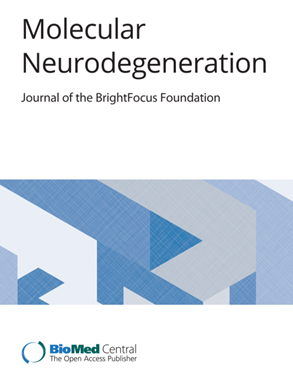Amyloid-β specific regulatory T cells attenuate Alzheimer’s disease pathobiology in APP/PS1 mice
IF 14.9
1区 医学
Q1 NEUROSCIENCES
引用次数: 0
Abstract
Regulatory T cells (Tregs) maintain immune tolerance. While Treg-mediated neuroprotective activities are now well-accepted, the lack of defined antigen specificity limits their therapeutic potential. This is notable for neurodegenerative diseases where cell access to injured brain regions is required for disease-specific therapeutic targeting and improved outcomes. To address this need, amyloid-beta (Aβ) antigen specificity was conferred to Treg responses by engineering the T cell receptor (TCR) specific for Aβ (TCRAβ). The TCRAb were developed from disease-specific T cell effector (Teff) clones. The ability of Tregs expressing a transgenic TCRAβ (TCRAβ -Tregs) to reduce Aβ burden, transform effector to regulatory cells, and reverse disease-associated neurotoxicity proved beneficial in an animal model of Alzheimer’s disease. TCRAβ -Tregs were generated by CRISPR-Cas9 knockout of endogenous TCR and consequent incorporation of the transgenic TCRAb identified from Aβ reactive Teff monoclones. Antigen specificity was confirmed by MHC-Aβ-tetramer staining. Adoptive transfer of TCRAβ-Tregs to mice expressing a chimeric mouse-human amyloid precursor protein and a mutant human presenilin-1 followed measured behavior, immune, and immunohistochemical outcomes. TCRAβ-Tregs expressed an Aβ-specific TCR. Adoptive transfer of TCRAβ-Tregs led to sustained immune suppression, reduced microglial reaction, and amyloid loads. 18F-fluorodeoxyglucose radiolabeled TCRAβ-Treg homed to the brain facilitating antigen specificity. Reduction in amyloid load was associated with improved cognitive functions. TCRAβ-Tregs reduced amyloid burden, restored brain homeostasis, and improved learning and memory, supporting the increased therapeutic benefit of antigen specific Treg immunotherapy for AD.淀粉样蛋白-β特异性调节性 T 细胞可减轻 APP/PS1 小鼠阿尔茨海默病的病理生物学特性
调节性 T 细胞(Tregs)可维持免疫耐受。虽然 Treg 介导的神经保护活性现已得到广泛认可,但由于缺乏明确的抗原特异性,其治疗潜力受到了限制。这一点在神经退行性疾病中尤为明显,因为这种疾病需要细胞进入损伤的脑区,以实现特定疾病的靶向治疗并改善疗效。为了满足这一需求,我们通过对 Aβ(TCR)特异性 T 细胞受体(TCR)进行工程化,赋予 Treg 反应以淀粉样蛋白-β(Aβ)抗原特异性。TCRAb是从疾病特异性T细胞效应物(Teff)克隆中开发出来的。在阿尔茨海默病动物模型中,表达转基因 TCRAβ 的 Tregs(TCRAβ -Tregs)能够减少 Aβ 负担,将效应细胞转化为调节细胞,并逆转与疾病相关的神经毒性。TCRAβ -Tregs是通过CRISPR-Cas9敲除内源性TCR,然后加入从Aβ反应性Teff单克隆中鉴定出的转基因TCRAb而产生的。MHC-Aβ-四聚体染色证实了抗原特异性。将 TCRAβ-Tregs 接种转移到表达小鼠-人类淀粉样前体蛋白嵌合体和突变型人类 presenilin-1 的小鼠体内后,对小鼠的行为、免疫和免疫组化结果进行了测定。TCRAβ-Tregs表达了Aβ特异性TCR。TCRAβ-Tregs的适应性转移导致了持续的免疫抑制、小胶质细胞反应和淀粉样蛋白负荷的减少。18F-氟脱氧葡萄糖放射性标记的TCRAβ-Treg可进入大脑,促进抗原特异性。淀粉样蛋白负荷的减少与认知功能的改善有关。TCRAβ-Tregs减少了淀粉样蛋白负荷,恢复了大脑稳态,改善了学习和记忆,支持了抗原特异性Treg免疫疗法对AD的治疗效果。
本文章由计算机程序翻译,如有差异,请以英文原文为准。
求助全文
约1分钟内获得全文
求助全文
来源期刊

Molecular Neurodegeneration
医学-神经科学
CiteScore
23.00
自引率
4.60%
发文量
78
审稿时长
6-12 weeks
期刊介绍:
Molecular Neurodegeneration, an open-access, peer-reviewed journal, comprehensively covers neurodegeneration research at the molecular and cellular levels.
Neurodegenerative diseases, such as Alzheimer's, Parkinson's, Huntington's, and prion diseases, fall under its purview. These disorders, often linked to advanced aging and characterized by varying degrees of dementia, pose a significant public health concern with the growing aging population. Recent strides in understanding the molecular and cellular mechanisms of these neurodegenerative disorders offer valuable insights into their pathogenesis.
 求助内容:
求助内容: 应助结果提醒方式:
应助结果提醒方式:


